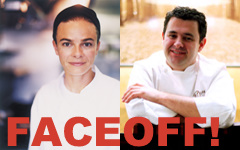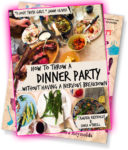Podcast: Play in new window | Download
This week, I read through a recipe a friend brought me. She had eaten the dish and gotten the recipe, but it seemed very complicated. In this episode, I go through line by line to see where shortcuts can be taken, then compare it with another bread pudding recipe to show how the techniques differ–and which one is better for home cooks.
The main recipe I’m looking at is Coconut Bread Pudding, by Laurent Tourondel. It was originally printed in the New York Times, and I’m reposting a version of it here for the people who aren’t already registered at our fine newspaper of record’s website.

Coconut Bread Pudding
Adapted from Laurent Tourondel
Time: 45 minutes plus one hour’s resting6 large eggs
1 1/8 cups sugar, more for topping dish
2 cups heavy cream
1 13 1/2-ounce can coconut milk
2 tablespoons dark rum
10 slices challah or sliced brioche, 1/3 inch thick.1. In bowl of an electric mixer fitted with a whisk attachment, combine eggs and 1 1/8 cups sugar. Mix until smooth. In a small pan, bring cream to a boil. With mixer running at medium-low speed, slowly add hot cream. Add coconut milk and rum, and mix again just until smooth. Allow mixture to rest at room temperature for one hour.
Dana Bowen in The New York Times, February 23, 2005
2. Heat oven to 350 degrees. Fill a kettle with water and place over high heat to bring to a boil. In an 8 1/2-by-12-inch baking dish, arrange challah slices so they overlap in two columns. Pour custard evenly over top, and press down lightly with a spatula. Place dish in a large, deep pan, like a roasting pan. Carefully pour in boiling water so that it comes about halfway up the sides of baking dish. Bake until custard is set but not too firm, 30 to 35 minutes.
I compare this recipe with Suzanne Goin’s recipe for Caramelized Bread Pudding with Chocolate and Cinnamon, from her book Sunday Suppers at Lucques.
(I’m not posting the full source in this case, because you can read the whole thing without registering at Cookstr, a great recipe resource. Everything there comes from published cookbooks, so you know they’re at least moderately field-tested. And Suzanne Goin’s book is great!)
Listen to the full podcast for details, but essentially, you can follow Goin’s technique with Tourondel’s flavors. This strategy of comparing several recipes for a certain type of dish, regardless of flavoring, is a great way to figure out which details in a recipe matter to you, and how you can adjust one recipe to suit your style of cooking.
Reminder: a lot of my cooking advice is also available in How to Throw a Dinner Party Without Having a Nervous Breakdown, my cookbook with Tamara Reynolds. Available where all fine ebooks are sold.

